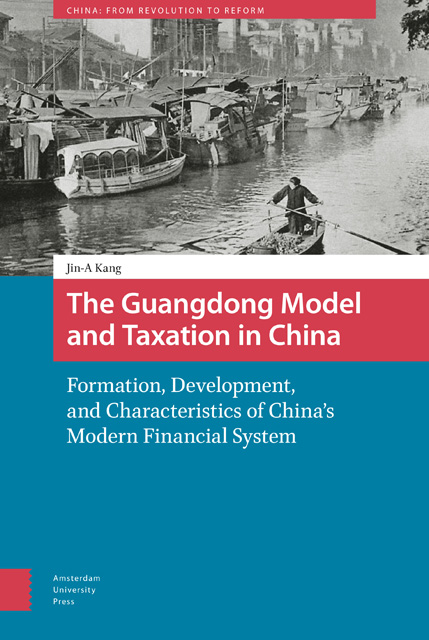 The Guangdong Model and Taxation in China
The Guangdong Model and Taxation in China Book contents
- Frontmatter
- Table of Contents
- Abbreviations
- Acknowledgments
- Introduction: The Modern Transformation of the Imperial Fiscal System: The Case of Provincial Finance in Guangdong
- Part 1 New Tax Revenues in Guangdong during the Republican Era
- Part 2 State-led Industrialization and the State Monopoly
- Part 3 Reform of Tax Collection
- Part 4 The Transition of the Modern Chinese Tax Structure in a Global Context
- Bibliography
- Glossary
- Index
2 - Tobacco and Wine Taxes in Guangdong and Changes in the Financial Structure during Republican China
Published online by Cambridge University Press: 10 January 2023
- Frontmatter
- Table of Contents
- Abbreviations
- Acknowledgments
- Introduction: The Modern Transformation of the Imperial Fiscal System: The Case of Provincial Finance in Guangdong
- Part 1 New Tax Revenues in Guangdong during the Republican Era
- Part 2 State-led Industrialization and the State Monopoly
- Part 3 Reform of Tax Collection
- Part 4 The Transition of the Modern Chinese Tax Structure in a Global Context
- Bibliography
- Glossary
- Index
Summary
Abstract
This chapter explores the history of the tobacco and wine taxes in Guangdong in the context of China's fiscal transformation. This case highlights the experience of Guangdong as a pioneering model for the Chinese fiscal state. The tobacco and wine taxes in China began as a type of likin in the late Qing in response to the needs of the military budget, but it gradually developed into an independent tax. The taxation on cigarettes was distinctive in that it was a tax on a modern enterprise. The revolutionary Nationalist regime in Guangzhou reorganized and effectively enforced tobacco and wine taxes in Guangdong. Other new taxes, such as the consolidated tax, first introduced in Guangdong, were expanded nationwide by the Nanjing Nationalist Government.
Keywords: tobacco tax, wine tax, consolidated tax, China, Guangdong
This chapter explores the history of the tobacco and wine taxes in Guangdong in the context of China's financial transformation. This case highlights the experience of Guangdong as a pioneering model for the Chinese fiscal state. The financial system of the central government in the Qing dynasty mainly relied on land taxes from the provinces, with few tax sources exclusively controlled by the central government. This financial structure did not change until the end of the late Qing dynasty. With the beginning of the Republican era, the central government sought to ensure its continued access to independent financial resources through a division between national and local taxes. The most prominent feature of China's financial transformation in the twentieth century was the growing importance of industrial and commercial taxes as a form of indirect taxes. Even in the twenty-first century, almost half of Chinese tax revenue is derived from indirect taxes, while the proportion of direct taxes, such as the income tax or the inheritance tax, remains low.
Of the several new taxes introduced in modern China, the tobacco and wine taxes were the only successful taxes that survived and developed into a main source of tax revenue during the Republican era. Under Nationalist rule, business taxes, income taxes, and other modern taxes were modestly and only partially introduced.
- Type
- Chapter
- Information
- The Guangdong Model and Taxation in ChinaFormation, Development, and Characteristics of China's Modern Financial System, pp. 49 - 66Publisher: Amsterdam University PressPrint publication year: 2022
